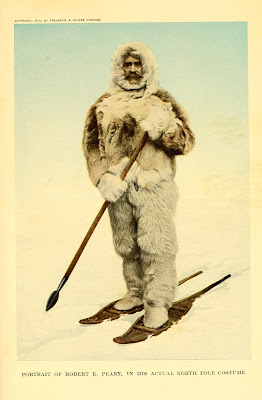Winter is underway, so it's time for the story
of one frosty adventure. More than one hundred year ago, Robert Edwin Peary set
out on his expedition to the North Pole. And do you know which animal he would
meet during this adventure? All of this you can see on our BLE –Expeditions.
 |
| Robert Edwin Peary |
The
steamship Roosevelt, with Peary's expedition party aboard sailed from New York.
After a stop in the Canadian port of Sydney, Nova Scotia, the Roosevelt arrived
in Etah, Greenland on August 8th, and continued on to Cape Sheridan
on Ellesmere Island, where they spent the winter. From a base station on Cape
Columbia, the expedition set out in February, 1909.
 |
| Five flags at the pole |
On
April 2nd, the remaining distance to the pole was only 224 kilometers.
Peary and Matthew Henson, together with Eskimos Ooqueah, Eginghwah, Seegloo and
Ootah, using five sleds and 40 dogs, with superhuman effort, marched for five
days. On April 6th, 1909 at 10am, Peary and his team reached 89°57'.
After a short rest, they set off again and late that afternoon reached the
northernmost point on the earth.
 |
| The period map of the Arctic Region |
Civil
Engineer Robert Edwin Peary was born on May 6th, 1856 in Cresson,
Pennsylvania, died on February 20th, 1920 in Washington, and is
buried in Arlington Cemetery. A peninsula in northern Greenland is named Peary
Land, in his honor, and a passage in the north Canadian Arctic is named the
Peary Channel.
 |
| Pacific Walrus |
Close
to the North Pole you can meet walruses. Walruses are typical inhabitants of
cold Arctic waters. These mammals, which are closely related to sea lions, can
weigh up to 1700 kg and growing to lengths of 3
m. They eat mainly snails, clams, crabs and echinoderms.
 |
| Spoted Walrus by Captain Budd Christman, NOAA Corps (Souce EOL) |
More of interesting stories are waiting for you on BLE, Stay tuned!

No comments:
Post a Comment